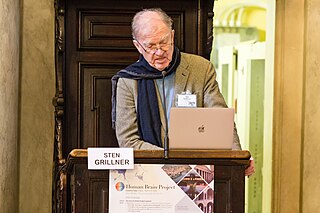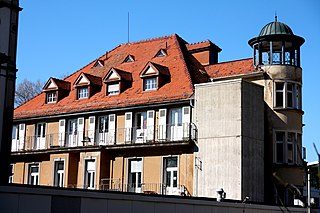Computational neuroscience is a branch of neuroscience which employs mathematics, computer science, theoretical analysis and abstractions of the brain to understand the principles that govern the development, structure, physiology and cognitive abilities of the nervous system.
Edmund T. Rolls is a neuroscientist and Professor at the University of Warwick.
Mriganka Sur is the Newton Professor of Neuroscience and Director of the Simons Center for the Social Brain at the Massachusetts Institute of Technology. He is also a Visiting Faculty Member in the Department of Computer Science and Engineering at the Indian Institute of Technology Madras and N.R. Narayana Murthy Distinguished Chair in Computational Brain Research at the Centre for Computational Brain Research, IIT Madras. He was on the Life Sciences jury for the Infosys Prize in 2010 and has been serving as Jury Chair from 2018.

Sten Grillner is a Swedish neurophysiologist and distinguished professor at the Karolinska Institute's Nobel Institute for Neurophysiology in Stockholm where he is the director of that institute. He is considered one of the world's foremost experts in the cellular bases of motor behaviour. His research is focused on understanding the cellular bases of motor behaviour; in particular, he has shown how neuronal circuits in the spine help control rhythmic movements, such as those needed for locomotion. He is the current secretary general of the International Brain Research Organization (IBRO) and president of the Federation of European Neuroscience Societies (FENS). For his work, in 2008 he was awarded the $1 million Kavli Prize for deciphering the basic mechanisms which govern the development and functioning of the networks of cells in the brain and spinal cord. This prize distinguish the recipient from the Nobel prizes in basic medical sciences.

NEST is a simulation software for spiking neural network models, including large-scale neuronal networks. NEST was initially developed by Markus Diesmann and Marc-Oliver Gewaltig and is now developed and maintained by the NEST Initiative.

Daniel Mark Wolpert FRS FMedSci is a British medical doctor, neuroscientist and engineer, who has made important contributions in computational biology. He was Professor of Engineering at the University of Cambridge from 2005, and also became the Royal Society Noreen Murray Research Professorship in Neurobiology from 2013. He is now Professor of Neurobiology at Columbia University.

John O'Keefe, is an American-British neuroscientist, psychologist and a professor at the Sainsbury Wellcome Centre for Neural Circuits and Behaviour and the Research Department of Cell and Developmental Biology at University College London. He discovered place cells in the hippocampus, and that they show a specific kind of temporal coding in the form of theta phase precession. He shared the Nobel Prize in Physiology or Medicine in 2014, together with May-Britt Moser and Edvard Moser; he has received several other awards. He has worked at University College London for his entire career, but also held a part-time chair at the Norwegian University of Science and Technology at the behest of his Norwegian collaborators, the Mosers.
Laurence Frederick Abbott is an American theoretical neuroscientist, who is currently the William Bloor Professor of Theoretical Neuroscience at Columbia University, where he helped create the Center for Theoretical Neuroscience. He is widely regarded as one of the leaders of theoretical neuroscience, and is coauthor, along with Peter Dayan, on the first comprehensive textbook on theoretical neuroscience, which is considered to be the standard text for students and researchers entering theoretical neuroscience. He helped invent the dynamic clamp method alongside Eve Marder.

Michael A. Häusser FRS FMedSci is professor of Neuroscience, based in the Wolfson Institute for Biomedical Research at University College London (UCL).
György Buzsáki is the Biggs Professor of Neuroscience at New York University School of Medicine.

The Bernstein Center Freiburg (BCF) is the central facility for experimental and theoretical research in the areas of computational neuroscience and neurotechnology at the University of Freiburg. As a member of the national network for computational neuroscience (NNCN), founded by the Federal Ministry of Education and Research (BMBF) in 2004, the BCF is one of a total of six Bernstein Centers in Germany. Like the other Bernstein Centers, it was named after the German physiologist Julius Bernstein. The BCF is located in the former Institute of Brain Research ("Neurophys") in Freiburg-Herdern. Initially known as Bernstein Center for Computational Neuroscience Freiburg (BCCN), the institute was renamed Bernstein Center Freiburg in 2010. The coordination site for the national Bernstein Network resides in the building of the Bernstein Center Freiburg.

Upinder Singh Bhalla is an Indian computational neuroscientist, academic and a professor at National Centre for Biological Sciences of the Tata Institute of Fundamental Research. He is known for his studies on neuronal and synaptic signalling in memory and olfactory coding using computational and experimental methods and is an elected fellow of the Indian Academy of Sciences and the Indian National Science Academy. The Council of Scientific and Industrial Research, the apex agency of the Government of India for scientific research, awarded him the Shanti Swarup Bhatnagar Prize for Science and Technology, one of the highest Indian science awards, in 2007, for his contributions to biological sciences. The Infosys Science Foundation awarded him the Infosys Prize 2017 in Life Sciences for his pioneering contributions to the understanding of the brain's computational machinery.

Robin Angus Silver is Professor of Neuroscience and a Wellcome Trust Principal Research Fellow at University College London. His laboratory studies neurotransmission and artificial neural networks by combining in vitro and in vivo experimental approaches with quantitative analysis and computational models developed in silico.
Claudia Clopath is a Professor of Computational Neuroscience at Imperial College London and research leader at the Sainsbury Wellcome Centre for Neural Circuits and Behaviour. She develops mathematical models to predict synaptic plasticity for both medical applications and the design of human-like machines.
Camilla Bellone is an Italian neuroscientist and assistant professor in the Department of Basic Neuroscience at the University of Geneva, in Switzerland. Bellone's laboratory explores the molecular mechanisms and neural circuits underlying social behavior and probes how defects at the molecular and circuit level give rise to psychiatric disease states such as Autism Spectrum Disorders.
The IBRO Dargut and Milena Kemali International Prize for Research in the field of Basic and Clinical Neurosciences' is a prize awarded every two years to an outstanding researcher, under 45 years old, who made important contributions in the field of Basic and Clinical Neurosciences. The award was established in 1998.

Wulfram Gerstner is a German and Swiss computational neuroscientist. His research focuses on neural spiking patterns in neural networks, and their connection to learning, spatial representation and navigation. Since 2006 Gerstner has been a full professor of Computer Science and Life Sciences at École Polytechnique Fédérale de Lausanne (EPFL), where he also serves as a Director of the Laboratory of Computational Neuroscience.

Julijana Gjorgjieva is a Macedonian-German professor of computational neuroscience at the Technical University of Munich and a research group leader at the Max Planck Institute for Brain Research. Her laboratory studies neural circuit formation.
Beat H. Gähwiler, is a Swiss emeritus professor in neuroscience at the Brain Research Institute of the University of Zurich, Switzerland.
Sonja Hofer is a German neuroscientist studying the neural basis of sensory perception and sensory-guided decision-making at the Sainsbury Wellcome Centre for Neural Circuits and Behaviour. Her research focuses on how the brain processes visual information, how neural networks are shaped by experience and learning, and how they integrate visual signals with other information in order to interpret the outside world and guide behaviour. She received her undergraduate degree from the Technical University of Munich, her PhD at the Max Planck Institute of Neurobiology in Martinsried, Germany, and completed a post doctorate at the University College London. After holding an Assistant Professorship at the Biozentrum University of Basel in Switzerland for five years, she now is a group leader and Professor at the Sainsbury Wellcome Centre for Neural Circuits and Behaviour since 2018.









